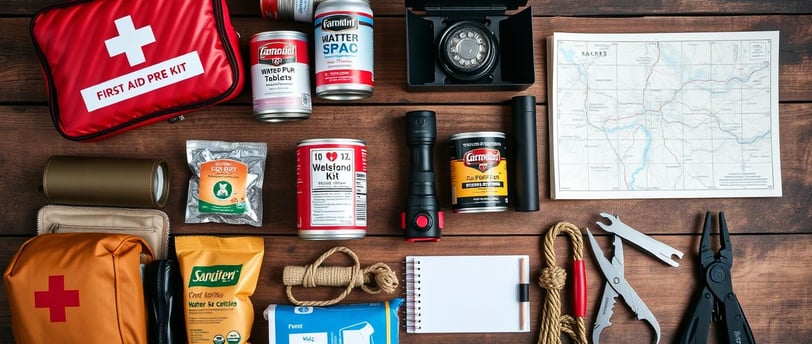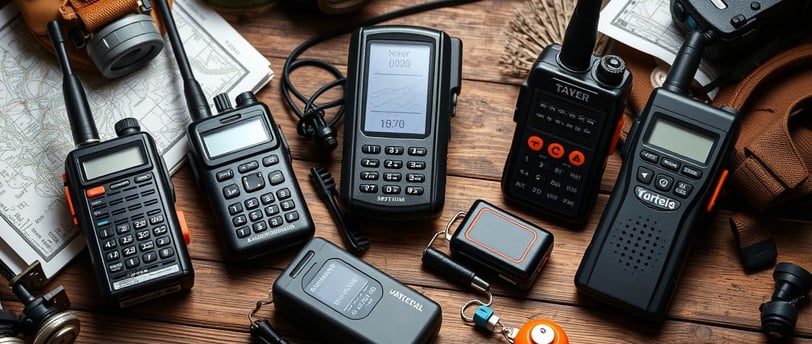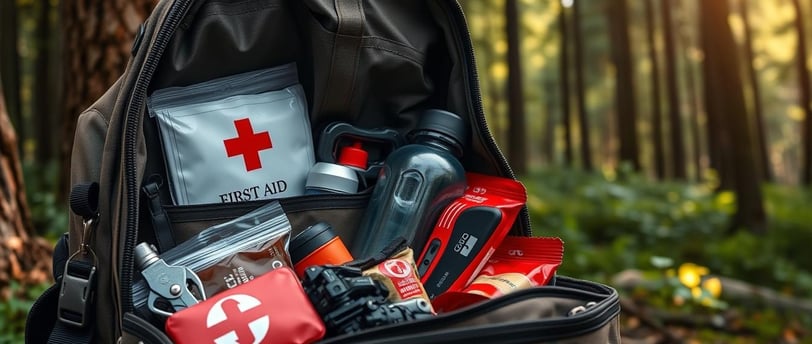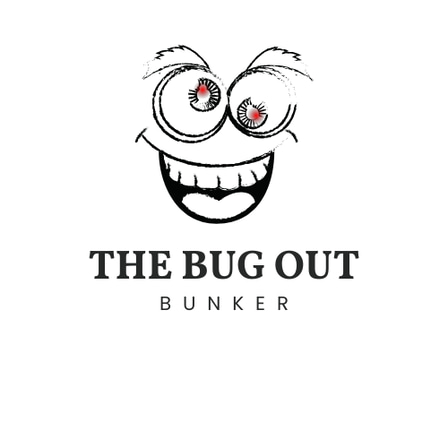Preppers Emergency Preparedness Checklist Essentials
This comprehensive guide provides a step-by-step approach to emergency preparedness for beginners. It covers essential supplies, skills, and planning strategies to help individuals and families prepare for various potential crises and disasters.
The Bug Out Bunker
8/30/202410 min read


Key Takeaways
Develop a comprehensive emergency preparedness checklist to ensure you have the necessary supplies during a crisis.
An emergency kit should include water, non-perishable food, first aid supplies, communication devices, and other essential items.
Customize your kit to meet your specific needs, such as prescription medications, pet supplies, and important documents.
Regularly maintain and update your emergency kit to ensure it's ready for any situation.
Familiarize yourself with basic survival skills to enhance your preparedness and resilience.
"sane prepper rules "https://theprepared.com/prepping-basics/guides/sane-prepper-mantra/
What is a Prepper's Emergency Preparedness Kit?
A prepper's emergency preparedness kit is key in emergency situations. It's filled with vital supplies and gear to help you survive sudden disasters or emergencies. It's important to be ready for the unexpected, as you might need to rely on yourself for days or weeks.
Importance of Being Prepared for Emergencies
Emergencies can happen fast, disrupting our lives and leaving us exposed. Having a emergency preparedness kit means you and your family have what you need to get through tough times. This kind of disaster preparedness brings peace of mind and confidence in facing any challenge.
Key Components of an Emergency Preparedness Kit
An emergency supplies list for a prepper's kit includes:
Water and non-perishable food
First aid supplies
Communication devices
Light sources
Personal hygiene items
Important documents
Tools and equipment
Make sure the essential emergency kit items fit your needs and update them often. This keeps them useful and current.
Water: The Lifeline in Emergencies
In emergency situations, water is key. Experts say you should store one gallon of water per person per day for at least three days. Aim for a two-week supply if you can. This water is vital for drinking, cooking, and staying clean.
Having clean water is crucial in emergencies. It keeps you hydrated, helps your body work right, and keeps you germ-free. Without it, you're at risk of getting very sick.
When getting ready for emergencies, focus on storing water. You might need to buy containers or filters. Or, think about collecting rainwater. A good emergency water supply keeps your family safe and healthy during tough times.
"Preparedness is the key to weathering any storm, and water is the foundation of that preparedness."
Being proactive helps a lot in emergencies. Take time to think about how much water you need. Make sure your family is ready for any surprises.
Being ready for emergencies can save lives.
Crises can happen suddenly, leaving you and your family at risk without the right supplies.
That's why having a detailed emergency checklist is key to surviving unexpected disasters or power cuts.
A prepper's emergency kit is your go-to tool in emergencies.
It's filled with must-have items that aid you and your family in tough times.
Whether it's a natural disaster, societal collapse, or just a power outage, these essentials can ease the stress and uncertainty.
Food: Stocking Up on Essentials
Having a well-stocked pantry is key in emergency preparedness. Along with a reliable water supply, it's vital to have non-perishable and easy-to-prepare foods. These items can help during power outages or other crises.
Non-Perishable and Easy-to-Prepare Items
When prepping for emergencies, pick foods that last long and are easy to make without power. Some top picks include:
Canned goods (vegetables, fruits, beans, soups, meats)
Dry cereal and granola
Peanut butter and jelly
Crackers and energy bars
Powdered milk and instant coffee or tea
Specialized Dietary Requirements
Don't forget about special diets in your household when planning meals without power. You might need:
Baby formula and food
Gluten-free or allergen-free options
Pet food and supplies
Having a two-week supply of these items can give you peace of mind. It ensures your family stays nourished in an emergency.
Communication and Light Sources
In an emergency, having reliable ways to communicate and light is key. Make sure your emergency kit has the right tools. These tools help you stay informed and navigate in the dark.
Battery-Powered Radios and Flashlights
A battery-powered or hand-crank radio is vital. It lets you get updates on emergencies and follow instructions from authorities. Choose a radio that picks up AM/FM, weather band, and NOAA weather alerts. Flashlights are also a must-have. They provide light when the power is out.
Backup Power Sources
Keep your radios and flashlights for emergencies working with backup power for disasters. Have extra batteries, portable chargers, or a small generator ready. This way, your emergency communication devices will keep working during a power outage.
"Being prepared means being equipped with the proper tools to handle any crisis. Emergencies don't plan ahead, but you can."
By focusing on battery-powered radios and flashlights for emergencies, and having backup power for disasters, you can stay connected and lit. This helps you face any challenge.
"complete bug out bag checklist" https://theprepared.com/bug-out-bags/guides/bug-out-bag-list/


First Aid and Hygiene Supplies
Getting ready for emergencies is more than just having food and water. You also need an emergency first aid kit and important personal hygiene items. These items are key to staying healthy and safe in tough times.
Basic First Aid Kit Essentials
A good emergency first aid kit should have these things:
Bandages in various sizes
Antiseptic wipes or cream
Pain relievers, such as ibuprofen or acetaminophen
Gauze pads and rolls
Adhesive tape
Scissors and tweezers
Thermometer
Medications for any existing medical conditions
Personal Hygiene and Sanitation Items
Having personal hygiene and sanitation items is also crucial. They help keep you clean and stop illnesses from spreading in an emergency. You might need:
Soap and hand sanitizer
Toilet paper and feminine products
Disinfecting wipes
Trash bags and plastic gloves
Toothpaste and toothbrushes
Sunscreen and insect repellent
A well-prepared emergency preparedness kit gives you and your loved ones confidence and peace of mind in any crisis.
"Preparedness is the foundation of resilience. When disaster strikes, the right supplies can make all the difference."
Preppers Emergency Preparedness Checklist
Making a detailed preppers emergency checklist is key to being ready for any disaster. The basic items listed here are a good start. But, it's vital to tailor your emergency kit to fit your needs and the risks in your area.
Customizing Your Kit for Specific Needs
Think about adding special items to your preppers emergency checklist for your household's unique needs. This could include:
Prescription medications
Baby supplies, such as formula, diapers, and wipes
Pet-related items, including food, water, and any necessary medications
Personal hygiene products for specific medical conditions or preferences
Adaptive equipment or assistive devices for individuals with special needs
By personalizing your disaster preparedness kit, you make sure you and your loved ones are ready for any emergency. This way, you can face emergencies with confidence and peace of mind.
"The key to effective preparedness is to tailor your emergency kit to your unique circumstances and needs."
The preppers emergency checklist isn't for everyone. Take time to think about what you really need. Then, adjust your kit to make a personalized disaster preparedness plan. This will help keep you and your family safe during crises.
Maintaining and Updating Your Kit
Keeping your emergency preparedness kit up to date is key. Make sure to check the expiration dates on food, water, and meds. Replace anything that's past its due date. Also, do an annual review of your kit. Add or remove items as your needs change. This keeps you ready for any emergency.
Expiration Dates and Replenishment
It's important to watch the expiration dates of your emergency kit items. Food, water, and meds don't last forever. So, check and replace anything that's gone bad. This makes sure your kit is always ready for emergencies.
Annual Review and Adjustments
Don't forget to review your emergency kit every year. Go through each item and see what you need now. You might need to add new things, swap out old gear, or toss items you don't use anymore. Keeping your kit fresh helps you face emergencies better.
"Being prepared is not the same as being paranoid. It's about taking responsible steps to ensure your safety and the safety of your loved ones."
Remember, maintaining emergency kits, checking expiration dates, updating disaster supplies, and reviewing emergency preparedness are key. By staying alert and active, your emergency plans will always help you in times of need.
Bug Out Bags: Grab and Go Preparedness
Having a "bug out bag" ready for emergencies can save your life. This bag is a must-have, filled with vital supplies for 72 hours away from home. It's perfect for natural disasters, power outages, or any crisis, making sure you're ready to leave quickly.
A good bug out bag should have these items:
Water and non-perishable food
First aid kit and personal hygiene supplies
Flashlight, batteries, and portable phone charger
Important documents, such as identification, insurance cards, and cash
Warm clothing, sturdy shoes, and a rain poncho
Multi-tool, knife, and emergency blanket
With a bug out bag, you're set with the right bug out bags, emergency evacuation kits, and portable disaster supplies. Make sure to tailor it to your needs and the risks in your area.
"Being prepared doesn't mean living your life in fear. It means being responsible and willing to protect yourself and your loved ones."
It's important to check and update your bug out bag often. Replace old items and add new ones as needed. A well-prepared bug out bag gives you confidence and peace of mind during emergencies.
"list of 70+ items from the supermarket" https://theprepared.com/homestead/guides/supermarket-food-list/



Skills and Knowledge for Emergencies
Learning emergency preparedness skills is key to handling crises well. Knowing survival skills for disasters can be a lifesaver in tough times.
Basic Survival Skills to Learn
First aid is a top survival skill for disasters. It lets you help others and might save lives. Also, knowing how to start a fire, use a map and compass, and clean water is crucial in emergencies.
First aid
Fire-starting
Navigation
Water purification
Importance of Practice and Drills
It's vital to practice emergency plans often. This ensures you and your family know what to do in an emergency. Rehearsing helps build muscle memory and lowers stress during a crisis.
"The time to repair the roof is when the sun is shining."
Getting good at emergency preparedness skills and practicing emergency plans boosts your safety in disasters and emergencies.
Conclusion
Getting ready for emergencies is key to keeping your family safe. By making a detailed prepping for emergencies kit, you're helping your loved ones face any challenge. A good disaster preparedness checklist can really help when disaster hits.
It's important to tailor your kit to your family's needs and keep it updated. Always be ready and keep learning new skills. Being prepared shows that you care about your family's safety.
Emergency preparedness is a smart move for your family's safety and peace of mind. By working on your kit, you're giving your family the strength to overcome any crisis.
FAQ
What is a prepper's emergency preparedness kit?
A prepper's emergency kit is a set of basic supplies and gear. It helps you survive in emergencies or disasters. Being ready for emergencies means you can take care of yourself for days or weeks on your own.
Why is it important to be prepared for emergencies?
After an emergency, you might need to survive by yourself for a while. Having your own food, water, and supplies is key. A disaster kit keeps you and your family safe and comfortable during tough times.
What are the key components of an emergency preparedness kit?
Important items for an emergency kit include water, non-perishable food, first aid, communication tools, light sources, and hygiene items. Make sure your kit fits your needs and update it often.
How much water should I have in my emergency kit?
Aim for at least one gallon of water per person each day for three days. Ideally, have enough for two weeks. Clean water is vital for drinking, cooking, and staying clean, which is crucial in emergencies.
What type of non-perishable food should I include in my emergency kit?
Include canned goods, dry cereal, peanut butter, crackers, and energy bars in your kit. Don't forget items for special diets, like baby formula, gluten-free foods, or pet food.
What communication and lighting devices should be in my emergency kit?
Your kit should have a battery-powered or hand-crank radio for updates. Flashlights are key for moving around in the dark. Also, think about extra batteries, portable chargers, or a generator to keep devices running during outages.
What first aid and personal hygiene supplies should be in my emergency kit?
Your first aid kit should have bandages, antiseptic, pain relievers, and any needed medications. Include soap, hand sanitizer, toilet paper, and feminine products for hygiene and health during emergencies.
How do I customize my emergency preparedness kit?
Use the emergency kit checklist in this guide as a starting point. Tailor your kit to your specific needs and the risks in your area. Add items like prescription drugs, baby supplies, or pet items to make sure your kit suits your household.
How do I maintain and update my emergency preparedness kit?
Keeping your emergency kit up to date is vital. Check expiration dates on food, water, and meds and replace them as needed. Review your kit yearly, adjusting it as your needs change. This keeps you ready for different emergencies.
What is a bug out bag, and why is it important?
A bug out bag is a portable kit for emergencies where you need to leave your home quickly. It should have essentials like water, food, first aid, and important documents for at least 72 hours away from home.
What practical skills and knowledge are important for emergency preparedness?
Learning survival skills like first aid, fire-starting, and navigation is key. Practicing your emergency plans and drills is also crucial. This prepares you and your family to act right when emergencies happen.
Source Links
Build A Kit | Ready.gov - https://www.ready.gov/kit
Survival Kit Supplies - https://www.redcross.org/get-help/how-to-prepare-for-emergencies/survival-kit-supplies.html
Beginner's guide to (sane) prepping - https://theprepared.com/prepping-basics/guides/emergency-preparedness-checklist-prepping-beginners/
Further reading
Ultimate guide to your family bug out bag
Essential first aid basics
Survival food kits for long term storage
Thanks and best regards
The Bug Out Bunker
Visit the link below and Purchase your Emergency 250 Survival Kit Backpack
This post may contain affiliate links. If you make a purchase through one of these links, we may earn a small commission at no additional cost to you. We only recommend products and services that we have personally used and believe will add value to our readers. Your support helps us continue to provide valuable content. Thank you for your support!
Survival
Stay prepared for any scenario with our expert insights.
© 2024. All rights reserved.
